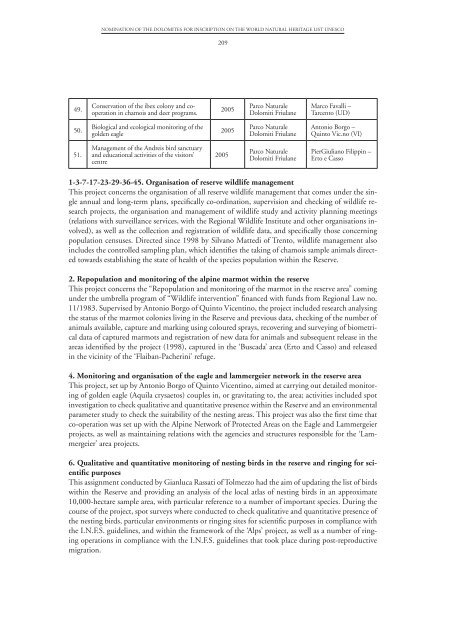DOLOMITES - Annexes 2-8 - Provincia di Udine
DOLOMITES - Annexes 2-8 - Provincia di Udine
DOLOMITES - Annexes 2-8 - Provincia di Udine
You also want an ePaper? Increase the reach of your titles
YUMPU automatically turns print PDFs into web optimized ePapers that Google loves.
49.<br />
50.<br />
51.<br />
NOMINATION OF THE <strong>DOLOMITES</strong> FOR INSCRIPTION ON THE WORLD NATURAL HERITAGE LIST UNESCO<br />
Conservation of the ibex colony and cooperation<br />
in chamois and deer programs.<br />
Biological and ecological monitoring of the<br />
golden eagle<br />
Management of the Andreis bird sanctuary<br />
and educational activities of the visitors’<br />
centre<br />
209<br />
2005<br />
2005<br />
2005<br />
Parco Naturale<br />
Dolomiti Friulane<br />
Parco Naturale<br />
Dolomiti Friulane<br />
Parco Naturale<br />
Dolomiti Friulane<br />
Marco Favalli –<br />
Tarcento (UD)<br />
Antonio Borgo –<br />
Quinto Vic.no (VI)<br />
PierGiuliano Filippin –<br />
Erto e Casso<br />
1-3-7-17-23-29-36-45. organisation of reserve wildlife management<br />
This project concerns the organisation of all reserve wildlife management that comes under the single<br />
annual and long-term plans, specifically co-or<strong>di</strong>nation, supervision and checking of wildlife research<br />
projects, the organisation and management of wildlife study and activity planning meetings<br />
(relations with surveillance services, with the Regional Wildlife Institute and other organisations involved),<br />
as well as the collection and registration of wildlife data, and specifically those concerning<br />
population censuses. Directed since 1998 by Silvano Matte<strong>di</strong> of Trento, wildlife management also<br />
includes the controlled sampling plan, which identifies the taking of chamois sample animals <strong>di</strong>rected<br />
towards establishing the state of health of the species population within the Reserve.<br />
2. Repopulation and monitoring of the alpine marmot within the reserve<br />
This project concerns the “Repopulation and monitoring of the marmot in the reserve area” coming<br />
under the umbrella program of “Wildlife intervention” financed with funds from Regional Law no.<br />
11/1983. Supervised by Antonio Borgo of Quinto Vicentino, the project included research analysing<br />
the status of the marmot colonies living in the Reserve and previous data, checking of the number of<br />
animals available, capture and marking using coloured sprays, recovering and surveying of biometrical<br />
data of captured marmots and registration of new data for animals and subsequent release in the<br />
areas identified by the project (1998), captured in the ‘Buscada’ area (Erto and Casso) and released<br />
in the vicinity of the ‘Flaiban-Pacherini’ refuge.<br />
4. monitoring and organisation of the eagle and lammergeier network in the reserve area<br />
This project, set up by Antonio Borgo of Quinto Vicentino, aimed at carrying out detailed monitoring<br />
of golden eagle (Aquila crysaetos) couples in, or gravitating to, the area; activities included spot<br />
investigation to check qualitative and quantitative presence within the Reserve and an environmental<br />
parameter study to check the suitability of the nesting areas. This project was also the first time that<br />
co-operation was set up with the Alpine Network of Protected Areas on the Eagle and Lammergeier<br />
projects, as well as maintaining relations with the agencies and structures responsible for the ‘Lammergeier’<br />
area projects.<br />
6. Qualitative and quantitative monitoring of nesting birds in the reserve and ringing for scientific<br />
purposes<br />
This assignment conducted by Gianluca Rassati of Tolmezzo had the aim of updating the list of birds<br />
within the Reserve and provi<strong>di</strong>ng an analysis of the local atlas of nesting birds in an approximate<br />
10,000-hectare sample area, with particular reference to a number of important species. During the<br />
course of the project, spot surveys where conducted to check qualitative and quantitative presence of<br />
the nesting birds, particular environments or ringing sites for scientific purposes in compliance with<br />
the I.N.F.S. guidelines, and within the framework of the ‘Alps’ project, as well as a number of ringing<br />
operations in compliance with the I.N.F.S. guidelines that took place during post-reproductive<br />
migration.

















